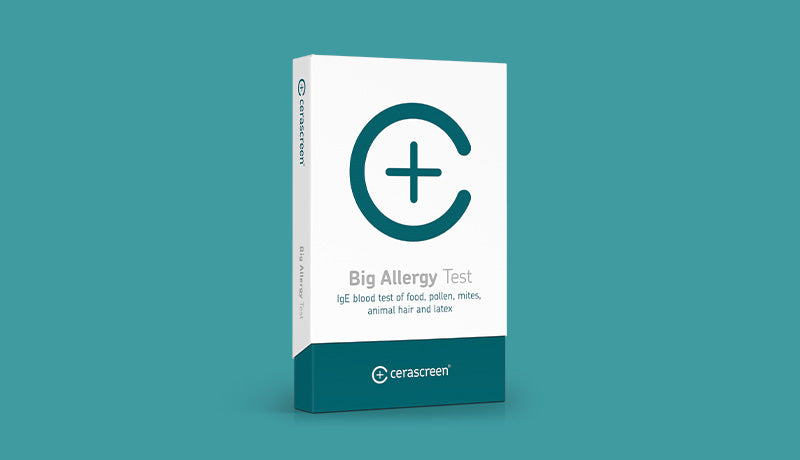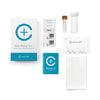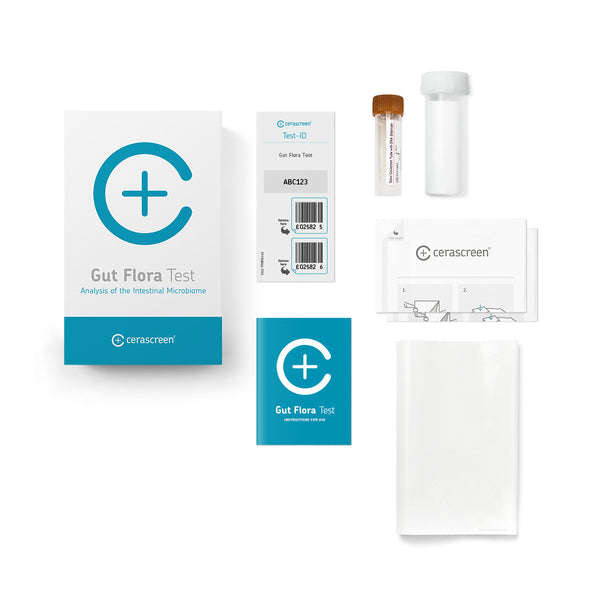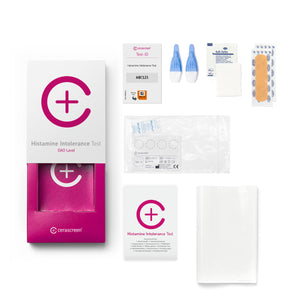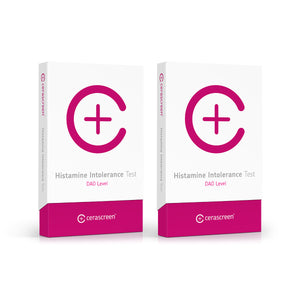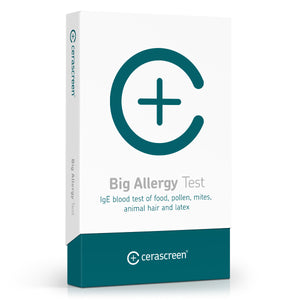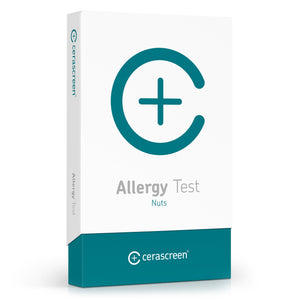product_id = 5044054523963variant_id = template_name =

Gut Flora Test
Analysis of intestinal bacteria and microbiome
About the test
With the cerascreen® Gut Microbiome Test, a diagnostic sample-taking and send-in test that you can use at home, the composition of the bacteria in your intestine can be determined. In a laboratory, the DNA of the intestinal bacteria is analysed using state-of-the-art biotechnology. With the results report, you will gain comprehensive insights into your microbiome, also called gut flora: from the variety of bacterial species to the balance between good and bad bacteria as well as the breakdown of all strains and types of intestinal bacteria.
Gut Flora Test
- Take your sample at home – conveniently and discreetly
- Receive a state-of-the-art DNA analysis
- Gain insights into the composition of your intestinal microbiome
- Get tips for your intestinal health
- Receive the result within three weeks after your sample’s arrival at the laboratory
Benefits of the Gut Flora Test
The gut microbiome, or gut flora, is a mirror of your health condition. Intestinal bacteria are important for your digestive and immune systems and are influenced by your lifestyle. An unhealthy or imbalanced diet, harmful substances, smoking, antibiotics and stress can throw the microbiome out of balance. Scientific studies indicate that this has an effect on digestion and can even increase your body weight.
Conventional intestinal flora tests analyse the stool sample by placing it in a Petri dish and looking at it through a microscope. However, this method only shows a section of the gut microbiome. rRNA sequencing is a more accurate, modern and diagnostic method that is used for the cerascreen® Gut Microbiome Test. It involves analysing the DNA of all bacteria in the stool sample.
DNA analysis of gut microbiome is usually not carried out by a medical practitioner. With the cerascreen® Gut Microbiome Test, you do not have to go to a clinic and do not have to wait for appointments. You will receive detailed, illustrated instructions and can take the sample quickly, conveniently and discreetly from home. You will then receive your individual gut microbiome profile.
Read more about why your gut flora is important

Result of the Gut Flora Test
As soon as your sample has been evaluated, you will receive your results report via the My cerascreen® app or your user account on our website. You can easily view the report on your smartphone, tablet or computer and print it out, if required.
Find out in the laboratory analysis what condition your gut microbiome is in. You will receive a breakdown of the most important bacterial strains in your gut and their relationship with each other. Learn from our clear recommendations about how to maintain healthy gut flora through nutrition, prebiotics and probiotics and nutritional supplements. Extensive health guidance explains the links between intestinal bacteria and health.
Frequently asked questions about Gut Flora Test
Why take the Gut Microbiome Test?
Do you wonder why you gain weight faster than others? What does the diet do to the bowels? Where do tummy rumbles and digestive problems come from? Why do I have a constant cold? Is my bowel healthy – and how do I actually find out? If this sounds familiar, the Gut Flora Test is just right for you. Because the bacteria in your gut reveals answers to these and other questions.
Studies indicate that our gut microbiome controls how quickly we gain weight, how well we digest carbohydrates, fat and other nutrients, how effectively our immune system fights off pathogens and much more.
The intestinal bacteria even transmit signals to the brain and may be related to your mood and the emergence of depression. If you learn more about your intestinal flora, you will gain insights into your physical and mental health as well.
All these and other topics are currently the subject of exciting scientific research, on which we keep you up to date in our Health Portal and our newsletters.
We still talk far too rarely about digestive problems and the gut. Unfortunately, these are still often topics that fall by the wayside. The cerascreen® Gut Microbiome Test gives you insights into your intestinal health and you can carry out the test discretely at home – simple, fast and safe.
Who should take the Gut Microbiome Test?
The Gut Microbiome Test is worthwhile for every adult (as of 18 years) who wants to learn more about the complexity of their gut.
The Gut Microbiome Test is also interesting for people who have to take antibiotics frequently. Because antibiotics do not just kill harmful bacteria, they can also disturb the good gut bacteria and reduce their diversity. After a course of antibiotics, it can take up to six months for the gut flora to recover.
Other factors that affect your gut microbiome include your genetic predisposition, medication, smoking, stress and environmental influences. A Gut Flora Test can therefore be particularly interesting if you take medication regularly, smoke or are under stress constantly.
How does the Gut Microbiome Test work?
To get your gut microbiome tested, you take a small stool sample yourself at home. To do this, use the stool collection aid and a collection spoon, both of which are included in the Gut Flora Test kit. Then send the sample in a sample collection tube to the medical laboratory using the provided prepaid return envelope.
The medical laboratory then uses modern biotechnology to analyse the DNA of the intestinal bacteria contained in the sample and compares it with the gene sequences of known bacteria. The analysis can take up to two weeks.
Caution: You should not do the Gut Microbiome Test if you suffer from diarrhoea or acute gastrointestinal infection.
How long does the analysis take in the laboratory?
Once your sample has arrived at the laboratory, it will be analyzed there by specialists. How long the analysis takes depends on the exact measuring method and the processes in the laboratory.
If the sample is sent on the correct days (Sunday to Tuesday), this makes it easier for the laboratory to adhere to the times.
For the Gut Flora Test, the laboratory analysis is usually completed within 15 working days after the sample is received in the laboratory.
What do I have to bear in mind when I take the sample?
The stool sample can be collected in the convenience of your home – simply, quickly and discretely. The Gut Microbiome testing kit includes detailed and illustrated instructions that explain all steps of the procedure in detail. There are a few things you need to bear in mind:
A bean-sized sample of your stool needs to be collected in the sample tube. Simply collect 3-4 small samples with the provided spoon that you find attached to the lid of the tube. If the sample is a little larger, this is not a problem.
The sample tube contains a DNA-stabilising liquid that mixes with the stool sample and ensures that the sample remains durable for a certain time. The sample does not have to be completely dissolved in the liquid. It is sufficient if the sample and liquid mix well.
You should in any case avoid direct contact with the DNA-stabilising liquid. The liquid can irritate your skin and eyes.
Because of the DNA-stabilising liquid, the sample is durable for a longer period of time; however, we recommend to send your sample to our medical partner laboratory on the day you collect your sample by using the free return envelope.
What does the result report tell me?
The results report contains a profile of your gut microbiome. This gives you a detailed insight into the composition of the bacteria that colonise your intestine. The results report also compares your results with the data of a healthy comparison group.
You will learn about your measured values: 1. species richness and diversity index: What is the diversity of bacteria that colonise your intestine? 2. Dysbiosis index: Is there an imbalance between "good" and "bad" bacteria in your gut? 3. Enterotype (intestinal type): Do you have the flora of a meat-eater or vegetarian? 4. Firmicutes/Bacteroidetes and Prevotella/Bacteroides ratio: Does your intestinal flora possibly contribute to a possible rapid weight gain? 5. Composition of bacterial strains (phyla): How are the four strains Bacteroidetes, Firmicutes, Proteobacteria & Actinobacteria distributed in your gut? Overview of all bacteria: Which functional bacteria and which species and genera occur within the bacterial strains?
More about these results and what they mean you can find out in answers further down on this page.
What is the gut microbiome?
Intestinal bacteria, intestinal fungi and other tiny organisms form your individual intestinal flora. Hundreds of millions of such microorganisms live in your gut – and they can grow to a total mass of 1.5 kilograms! The scientific term used today for the intestinal flora is the intestinal microbiome.
The intestinal flora performs important tasks and is closely linked to health in the whole body. The intestinal bacteria determine how your gut utilises food and how well the immune system is set up. The intestinal microbiome even impacts the brain and influences your mood and psyche.
If the complex gut microbiome is out of balance, it affects the whole body. Researchers suspect that an imbalance of bacteria in your gut causes digestive problems, abdominal pain, frequent infections and exhaustion, among other things.
What is the purpose of the gut microbiome?
Intestinal bacteria are an integral part of healthy digestion. In addition, they contribute to a strong immune system and perform a number of other tasks. Some known tasks include the following:
Digestion: Among other things, the intestinal bacteria produce vitamins and essential amino acids from food, as well as the butyrate, which contributes to gut health.
Immune system: The largest part of your immune system is located in the intestine. Therefore, gut microbiome plays a major role in strengthening these defences and keeping pathogens away. Scientific studies even suggest that healthy gut flora can ward off allergic reactions.
A gut feeling:There is probably a lot more to the term ‘gut feeling’ than we suspected. Researchers have discovered that gut bacteria also communicate with the brain. That way, the gut microbiome probably influences feelings and moods and can even have an effect on how depression develops.
Why is the biodiversity of bacteria important?
Biodiversity describes how many different types of bacteria exist in your gut flora. Simply put, the more types of bacteria, the better it is for your health. For instance, scientists believe that greater diversity helps prevent diseases and obesity.
With the diversity index given in the results report you will learn whether the bacterial species in your gut are fairly evenly distributed or if certain species of bacteria dominate your bowel.
What is the dysbiosis of the gut?
There are bacteria in your gut that scientists consider to be positive for your health; however, there are also bad gut bacteria. The good bacteria usually represent the majority, and a certain number of bad bacteria is still important for stimulating the immune system.
If you are experiencing dysbiosis, this simply means that your microbiome is out of balance. In this case, bad gut bacteria is more present in your bowel. The dysbiosis index in the results report of the cerascreen® Gut Microbiome Test can be used to define and determine a possible imbalance.
Many of the bad bacteria are found, for example, in people who suffer from inflammatory bowel diseases, such as Crohn’s disease or ulcerative colitis. As a result, researchers suggest shifting the balance of bacteria in favour of the positive ones.
What is a gut type?
Scientists classify the gut microbiome into different gut types, or ‘enterotypes’. Which gut type you have depends on the foods that you eat. Depending on your diet, your intestines require different bacteria to make the best use of the food.
There is a significant difference between people who consume a lot of animal fats, protein and sugar and those who eat mainly vegetarian food. The groups can be divided into these gut types:
B-type: In the guts of people who eat a lot of meat and rather few vegetables, the bacterial strain Bacteroides often predominates. The gut requires these bacteria in order to make best use of meat. Bacteroidetes then produce vitamins that are rare in a meat-based diet, such as vitamin C.
P-type: In the guts of people who consume mostly vegetables – for instance, vegetarians and vegans – the Prevotella bacteria often predominate. These bacteria utilise dietary fibres and other carbohydrates. In that process, they produce, among other things, folic acid and healthy short-chain fatty acids.
Why are children under 18 not allowed to take the test?
Our tests are not suitable for underage children and adolescents under the age of 18. Under 18s cannot activate the tests online and therefore cannot receive a test result. We ask that you do not administer the tests to your children either.
Children and adolescents need much closer supervision and counselling regarding medical tests and their interpretation. Testing with lancets and chemicals is not without risk and would need to be closely supervised by guardians. In addition, the reference values we give are always based on adult data. In the case of children, the risk of misinterpreting the results would be very high.
We want to fulfil our responsibility as a provider of medical products and ensure that children and adolescents are not unsettled by measurement results that are difficult for them to interpret. Since we cannot control whether the minors' legal guardians actually consent to the test being carried out and supervise them, we exclude tests for under 18s altogether.
If you are under 18 and have purchased a test, please contact our customer support.
Why does it take up to a week for the sample to reach the lab?
Please bear in mind that your results will not be analyzed in the UK but in Germany. For that reason, it can take up to a week for the sample to arrive at the lab. This does not affect the stability of the samples, as the method we are using is optimized for long transports.
Initially, your sample is sent to our collection center in the UK. From there, it is shipped to our central sample sorting facility in Germany, which then distributes samples to our partner laboratories. Once your sample is analyzed there, you will receive a notification and can access your result online.
Please check your mailbox regularly. We will notify you as soon as your sample is sent, arrives, or is analyzed.
Why does the test have an expiration date?
The cerascreen® test kits are CE-marked medical devices, which in turn include other certified medical components such as lancets, patches, and alcohol swabs used in blood tests.
Like most medical devices, these components have an expiration date to ensure that they remain safe and effective. Many of our sample carriers – such as dried blood cards or sample tubes – are chemically treated to keep your sample stable and analyzable in our laboratory. Over time, environmental factors can affect this treatment and compromise accuracy.
Our sterile, single-use lancets also carry an expiration date to guarantee sterility and safe use up to that time.
This is how it works
1. Test at home
Your test kit contains everything you need to take a small stool sample. Then send the sample back to us free of charge in the enclosed return envelope.
2. View results online
After the evaluation in the medical specialist laboratory, you will have online access to your personal result report.
3. Act
Your access to the test results and the evidence-based findings and tips to improve your health: the my cerascreen® user profile on our website or our app.
